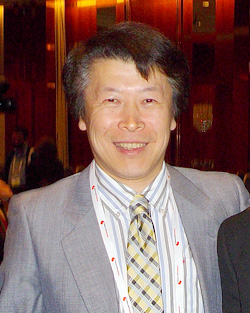
Main present positions
- ✔ Vice Medical Director, Division of Palliative Medicine Chief Director, Higashi Sapporo Hospital
- ✔ Clinical Professor, Department of Anesthesiology, Sapporo Medical University since 2008.
Bio-sketch
Born the 10th of April 1962, Kazuhiko Koike graduated from Sapporo Medical College at 1988 and chose Oncology section (Clinical Oncology, Gastroenterology, and Hematology) of Internal medicine (Section 4) of Sapporo Medical College. He hold Ph.D. from Sapporo Medical University (obtained in Jan 2003). His research has focused on the molecular mechanisms of cancer metastasis. His clinical and research experience include chemotherapy for cancer patients, supportive, and palliative care in cancer.
Currently he is vice medical director, and division of palliative care medicine chief director at Higashi Sapporo Hospital, where he has been providing comprehensive medical oncology and palliative care. In 2011 he was appointed as the chair of the organizing Committee in the 16th Congress of the Japanese Society for Palliative Medicine (JSPM). He is a Provisional Board Certified Senior Member of the JSPM and Chief executive officer of association for Palliative Medicine of Hokkaido. He has been elected in 2014 as Delegate to the JSPM. He is the Board Certified Gastroenterologist of The Japanese Society of Gastroenterology, and the Board of the Japanese Society of Internal Medicine. He is appointed as a palliative medicine section member of planning committee for the 13th Annual Meeting of Japanese Society of Medical Oncology in 2015.
Recent Publications (Peer-Reviewed Original Research Articles)
- 1. Koike K, Terui T, Takahashi Y, Hirayama Y, Mizukami N, Yamakage M, Kato J, Ishitani K: Effectiveness of multidisciplinary team conference on decision-making surrounding the application of continuous deep sedation for terminally ill cancer patients. Palliat Support Care. 2013 Nov 4: 1-8. [Epub ahead of print]
- 2. Terui T, Koike K, Hirayama Y, Kusakabe T, Ono K, Mihara H, Kobayashi K, Takahashi Y, Nakajima N, Kato J, Ishitani K: Recent Advances in Palliative Cancer Care at a Regional Hospital in Japan. Am J Hosp Palliat Care 2013 Sep 10. [Epub ahead of print]
- 3. Hirayama Y, Terui T, Kusakabe T, Koike K, Ono K, Kato J, Ishitani K: A Survey of Patients Who Were Referred to Our Palliative Care Division From Other Hospitals and Appeared to Have Obvious Indications for Cancer Chemotherapies. Am J Hosp Palliat Care 2013 Oct. 16. [Epub ahead of print]
- 4. Mizukami N, Yamauchi M, Koike K, Watanabe A, Ichihara K, Masumori N, Yamakage M : Olanzapine for the Prevention of Chemotherapy-Induced Nausea and Vomiting in Patients Receiving Highly or Moderately Emetogenic Chemotherapy: A Randomized, Double-Blind, Placebo-Controlled Study. J Pain Symptom Manage 2013 May. [Epub ahead of print]
緩和的鎮静とケアの質
要約
終末期がん患者における耐え難い苦痛症状を緩和させる方法の一つに緩和的鎮静というものがある。強い痛み、呼吸困難、嘔吐やその他の難治性で治療抵抗性と考えられる症状を持った患者に対して、残された最後の手段として緩和的鎮静による介入があることには、合意が得られている。提供できるあらゆる苦痛緩和をもたらす治療・ケアが無効で、死まで患者の意識を低下させること以外に有益な方法がない場合にのみ緩和的鎮静という方法を検討することが仮定される。緩和的鎮静は、質の高い緩和ケアを提供することに対する代わりの方法として考えられるようになっている。質の高いケアが適切に提供されていることは、緩和的鎮静を考慮する際の根本的・必須条件である。実際、緩和的鎮静の前には、痛みや抑うつ、せん妄、不安などのあらゆる緩和治療が、施行され尽くされなければならない。
しかし、緩和的鎮静の適応、実施、経過については、多くの医学的、倫理的に適切でない判断があるのが現状である。難治性(医学的に抵抗性)の定義はどのようにすべきであろうか?全ての可能な治療が無効である場合にその症状は難治性と定義される。さらに様々な分野の専門家らによって繰り返し十分なアセスメントを基盤としたチームの総意により評価される。緩和的鎮静は多職種チームが意思決定過程に参加した際にのみ、安全に適切に実施されるべきものである。
我々の病院では、主治医が緩和的鎮静の適応と考えている患者全てに対して、鎮静を実施する前に多職種チームカンファレンスを開催している。1581名の患者で、緩和的鎮静(深い持続的鎮静)の実施数は、22名(1.39%)であった。多職種チームカンファレンスの結果、鎮静適応外と判断され、鎮静以外の介入により症状コントロールが可能であった例が6例(0.38%)あった。深い持続的鎮静の施行は、多職種チームカンファレンスのような様々な方向からの意見交換による適切な適応決定の過程を経ることにより、減少することが示された。(1)
症状アセスメントや治療に対する多職種チームアプローチは、必須のものである。適切な緩和ケアというものは患者の苦痛の全ての点に配慮することを必要とする。これは、様々な医学的、看護や関係した医療専門職の関わりや手助け(多職種チームアプローチ)を必要とする。専門職間での継続したチームワークや良好な協働、情報交換、コミュニケーションは、緩和的鎮静の意思決定過程において必須のものである。こういった過程が欠けてしまうと、不適切なアセスメント、情報乖離に結びつき、苦痛をもたらしてしまうものと考えられる。
(1) Koike K, et al: Effectiveness of multidisciplinary team conference on decision-making surrounding the application of continuous deep sedation for terminally ill cancer patients. Palliat Support Care. 2013 Nov 4: 1-8. [Epub ahead of print]
(邦訳:小池和彦)










